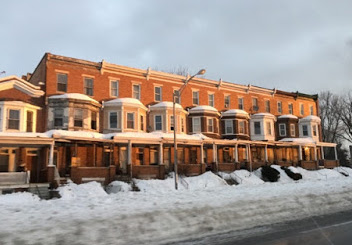Cities in particular have grown quite vulnerable in many respects, the intricate network of systems breaks down easily. cell phone connections that overload, water and sewer lines are rickety. But the automobile is in a league by itself. It can be easily immobilized by signal outages, by congestion or by snow. Designed to be this symbol of individual freedom and named for its mobility, it provides comfort and protection from weather with all the amenities of a home, but unlike the good old horse, all this is rendered useless if it is covered under two feet of snow or separated from a passable artery by 1/3 of a mile of impassable side-street.
 |
| snow piled up especially at crosswalks (Photo ArchPlan) |
Out in the burbs cleaning the car remains the first order of business followed by cleaning the driveway, preferably with a snowblower. That expensive tool has become part of the full arsenal of equipment which many suburban homeowners see as a necessity along with emergency generators, lawn tractors, leaf blowers and wood chippers. All those items sit in the garage and force the car outside to be freed of snow in the first place.
But I am digressing. In the city the geography is different. For the most part there is no driveway to clear and the arsenal of weapons stored in a rowhouse is limited to a shovel and a broom. Every inch of the street is either a drive-lane or a precious parking space which inevitably leads to a conundrum when it comes to deciding where to put the snow. There is a lot of switching back and forth going on between snow on the car and snow on the street, the latter usually not winding up back on the car but compacted and heavy piled and plowed against the car making the cleared path utterly non attainable. And I won't even get into that silly lawn-chair business which counter to local pride is not a Baltimore tradition but equally common in Philly, Pittsburgh and even Chicago.
 |
| Beayty and curse: Rosemont (Photo ArchPlan) |
So the first couple of days when folks are worried whether firetrucks and ambulances could reach them, residents are ecstatic if a plow shows up and clears even a single lane. But soon thereafter the mood changes if the parked vehicle remains immobilized. By now a quick run by a plow won't do the trick. Now front loaders are in demand and dump trucks and actual removal of the stuff is needed.
Clearly, that is a slow process and can impossibly be attained all across the city. Hundreds of often suburban private contractors are now in action instead of the municipal plow drivers who know their routes. They get paid time and expense and they may not always be motivated to do the most effective thing. So when the Mayor proclaims how many pieces of equipment and how many operators are doing snow removal, the sheer number means little if this army isn't guided by generals that have a clear plan.
That is where it seems to be lacking in City and County alike. Just as we see buses bunched behind each other, the second and third enjoying the low volume of riders in the wake of the first, so we see snow equipment congregating in the same spot over and over while many less prominent corners remain undetected.
I am not privy to the battle plan the Department of Public Works has and neither is anybody else. This leads to the suspicion that there really isn't one. And maybe it is asking for too much to have such a static top-down plan in a drawer. It would have to cover all the hundreds of miles of city streets for an infinite number of possible conditions.
Maybe a bottom up system would be better, one where the vast amounts of cash given to the army of private contractors is an allowance from which citizens call up services. The logistics wouldn't be that easy either, but they could be imagined somewhere along these lines: after the arterials are done, residents call for services from a pool of resources much in the way how FedEx pick ups are summoned by businesses or as 311 is supposed to work if it did work. The army of snow equipment operators would become a "fulfillment center" like the one we have in town from Amazon. Requests come in and the stuff gets dispatched as is most efficient. This would probably be most effective if there would be at least four such fulfillment centers, one in each quadrant of the city. And no, Roland Park wouldn't get the snazziest equipment!
Maybe most importantly, pedestrian pathways need to get priority over streets. If the Mayor wants to get the courageous peds off the streets, the sidewalks need to be cleared. What we see instead is that the sidewalks are the receiving areas for the street snow. The opposite of making walking easier. Should property owners be fined if sidewalks are not cleared? Damn right they should, especially commercial ones on highly travelled routes. Of course, homeowners should be cut some slack if cutting a path is physical impossible.
Whatever the best methods which are hotly debated all over town now, the predicted weekend temps will make most of this go away the natural way and the headlines of the daily papers will return to crime, trash removal, broken water pipes and all the other stuff that makes residents feel that government isn't so useless after all.
Anybody who thinks that resources could be better dispatched in all of these matters should go out to vote for the best City Council and the most innovative Mayor ever. April is the time to do that!
Klaus Philipsen, FAIA
No comments:
Post a Comment